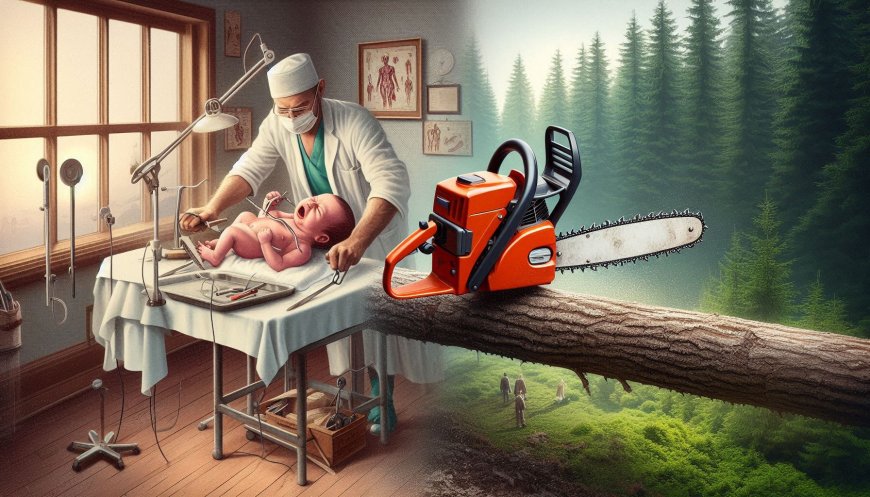The Unexpected Birthplace of the Chainsaw: From Childbirth to Forestry
Discover the unexpected origin of the chainsaw, from its early use in childbirth procedures to its modern-day role in forestry. Learn how this powerful tool evolved over time.

Picture a tool known for its roar through the forest, felling mighty trees with precision and power. Now imagine that same tool being used in the delicate, life-saving procedure of childbirth. As surprising as it may seem, the chainsaw, a symbol of rugged forestry and hard labor, was originally invented for a far more delicate and essential task: aiding in difficult childbirths.
Medical Origins of the Chainsaw
In the late 18th century, childbirth was a perilous event. Complications often arose when babies became stuck in the birth canal, posing serious risks to both mother and child. To address this life-threatening situation, Scottish doctors John Aitken and James Jeffray devised a tool that would forever alter the course of history: the first version of the chainsaw.
Far from the powerful machines used in modern-day forestry, this early chainsaw was a small, hand-cranked device intended for symphysiotomy procedures. Symphysiotomy involved cutting away parts of the pelvic bone and cartilage to widen the birth canal, helping the baby pass through. Before the chainsaw, this process was painstakingly slow and brutal, often done with a regular knife or small saw. But Aitken and Jeffray’s invention—referred to as a "flexible saw"—allowed surgeons to perform the procedure with much greater speed and precision, significantly improving the chances of survival for both mother and child.
Though the thought of using a chainsaw in a medical setting may sound gruesome today, back then it was seen as a medical marvel, a lifesaving tool that helped solve one of the most dangerous complications of childbirth.
The Evolution of the Chainsaw
The chainsaw’s medical use continued to evolve into the 19th century, with German physician Bernhard Heine developing the osteotome in 1830—a more refined version designed to cut through bone in surgeries. The osteotome featured a toothed chain, operated by a hand-cranked wheel, that made bone-cutting procedures far less traumatic for patients. Yet, despite its continued success in surgery, this chainsaw-like tool was still limited to the medical field.
It wasn’t until the early 20th century that the chainsaw would take on a new identity—one that would forever link it to the rugged world of forestry.
From Surgery to the Forest
As industrialization spread across the globe, new demands arose for efficient methods of cutting wood. Lumberjacks had long relied on axes and manual saws, but these tools were time-consuming and labor-intensive. Inventors, inspired by the medical chainsaw, began to imagine a tool that could tackle even the largest trees with the same precision and efficiency.
In 1883, the Chain Sawing Machine was patented, followed by the Endless Chain Saw in 1906. These innovations laid the groundwork for what we now know as the modern chainsaw. By 1918, Canadian inventor James Shand patented the first portable chainsaw, a machine that revolutionized woodcutting. Though still large and unwieldy, it represented a significant leap in efficiency for the forestry industry.
The true breakthrough came in 1926, when Andreas Stihl, a German engineer, developed and patented the first electric chainsaw. Just three years later, in 1929, Stihl introduced the gas-powered chainsaw, making the tool even more portable and powerful. These early models required two men to operate and were far from the sleek machines we use today. However, they quickly gained popularity among lumberjacks for their ability to cut down trees in a fraction of the time it took with traditional methods.
The Chainsaw’s Modern Legacy
World War II spurred further innovation, with lighter and more efficient chainsaws emerging in the post-war years. These new designs allowed for single-person operation, making the chainsaw even more accessible and versatile. From logging giants like redwoods to more domestic uses like firewood cutting, the chainsaw became an indispensable tool in both professional forestry and everyday life.
Today, the chainsaw is a far cry from its humble medical beginnings. Its journey from the operating room to the great outdoors is a testament to human ingenuity and our ability to adapt and repurpose technology for different needs. While its modern association may be with timber and power tools, the chainsaw’s origins tell a much deeper story—one of survival, innovation, and transformation.
So, the next time you hear the familiar buzz of a chainsaw, remember that this tool, now synonymous with raw power, was once a delicate instrument designed to save lives.
What's Your Reaction?






































































































